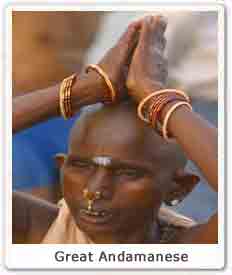Great Andamanese is the negrito tribe inhabitant in the the Andaman group of Islands. They form the largest population among the other tribes found in these islands.
 Language
and Clothing :
Language
and Clothing : Jeru, Khora and Andamani Hindi are some of the languages spoken by the Great Andamanese. Great Andamanese men wear narrow belts or girdles of hibiscus fiber. They tuck weapons into their belts when they go for haunting. Men also wear traditional cincture decorated with shells. Great Andamanese women wear branches of leaves cut into stripes and held by belts made of pandanus leaves. Great Andamanese girl wear tail skirt. They also love painting their bodies, which also protects them from the daily insects, direct sunlight and cold temperature. They are fond of wearing human bones around their neck and forehead.
Physical characteristics :
Great Andamanese are jet black in colour. They have broad face with the heavy body. They smear their head with the clay. Great Andamanese also cut their eyebrows. The women traditionally left only two narrow parallel bars from forehead to neck where the hair was allowed to grow longer than 3 mm. The men left a circular patch on top of the head, not more than 20 cm (8 inches)diameter, while shaving everything around the central patch.
History :
Before the advent of the Britishers in India, their was the great population of Great Andamanese in the Andaman islands. There were at least ten sub groups of the Great Andamanese. They had their own language, culture and traditions. But today most of their sub groups have extinct.
Population :
According to the census the population of Great Andamanese in the year 1789 was around 10,000. In the year their population decreased to 626. According to the reports their population further decreased to 24 individuals in the year 1971. But in 1999 their number increased to 41. The government is taking huge steps for the survival of these tribal people.
Food :
Great Andamanese are foragers. They eat rice, wheat, dal, chapati etc. They are also dependent on fish, dugong, turtle eggs, turtle, crabs, roots, seeds and tubers. They love eating pork and Andaman water monitor lizard.
Occupation :
Great Andamanese have been haunters for many centuries. They hunt for food. They are also seen cultivating vegetables for their livelihood. They have also established poultry farms.






